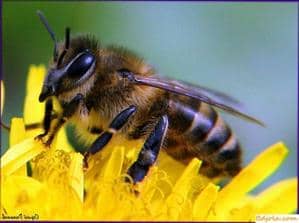
Wax is a product of the secretion of the wax glands of worker bees, which are placed in pairs on four segments in the lower part of the abdomen, and is released through the small apertures of the wax mirrors to the outside, where it solidifies in the form of transparent white plates of five-pointed shape. The most developed wax glands in young bees aged 12-18 days. At flying bees they gradually atrophy and cease to function.
Young bees excrete wax well only with satisfactory feeding with fresh honey and pollen. It is established that for the allocation of I kg of beeswax bees spend about 3.6 kg of honey. If the uterus is lost in the family, the bees cease the allocation of wax and the construction of honeycombs. This phenomenon is also observed in families that are preparing for swarming, i. e. the separation of wax is associated with the physiological state of the bees and the bee family as a whole.
Stimulates the formation of a large number of wax bribes: the larger it is, the more young bees. And the growth of the bee family leads to an increase in the production of wax. Under favorable conditions and with a good bribe for a season, one family can allocate 1.5-2.5 kg of wax.
In beekeeping, to increase the yield of wax, a different uterus is often held in the family. The additional quantity of young bees raised by her helps to increase the collection of honey and wax. In addition, you can feed bees honey pollen mixture (every day 300 grams per family: 100 grams of pergils with pollen mixed with 100 grams of honey, 100 grams of water and 2.5 grams of food baking soda). With such a top dressing 1 kg of bees can allocate 1.5 kg of wax. If you use two methods at the same time, you can get up to 6 kg of wax per season.
Биовит для пчел. Метка пчеломаток.
Beeswax